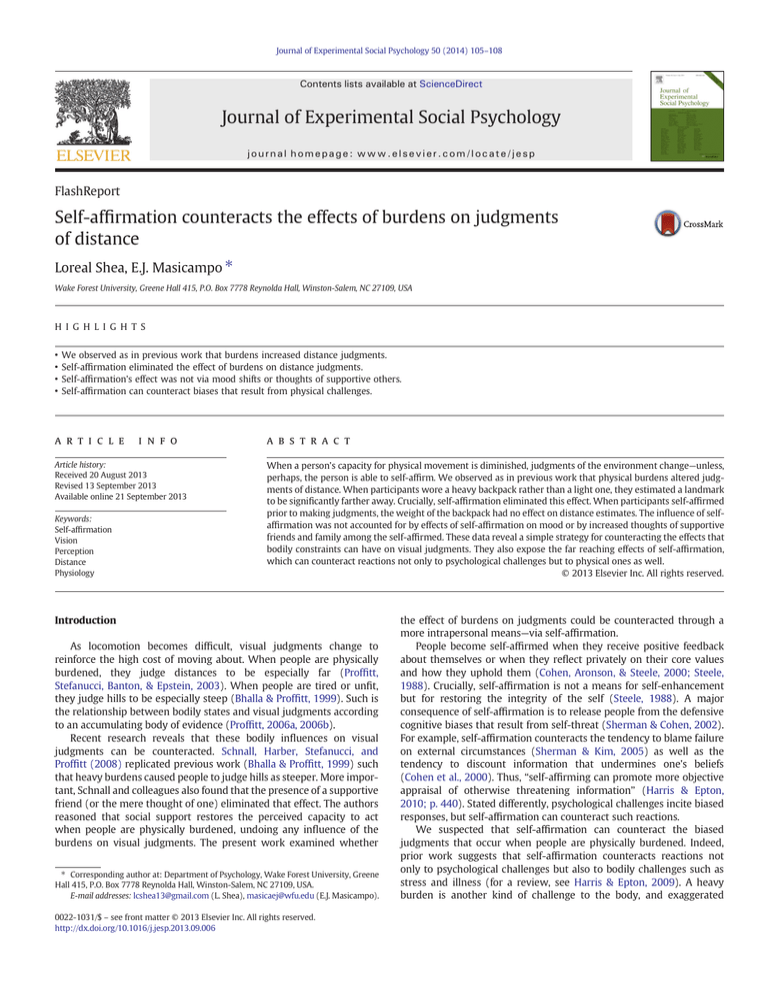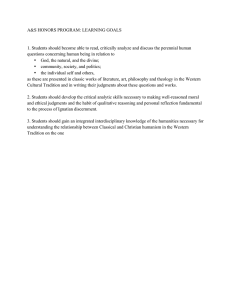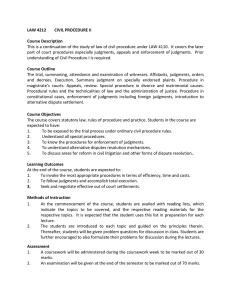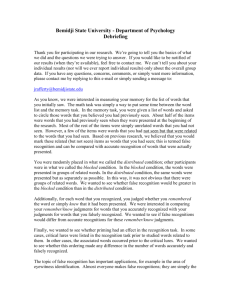
Journal of Experimental Social Psychology 50 (2014) 105–108
Contents lists available at ScienceDirect
Journal of Experimental Social Psychology
journal homepage: www.elsevier.com/locate/jesp
FlashReport
Self-affirmation counteracts the effects of burdens on judgments
of distance
Loreal Shea, E.J. Masicampo ⁎
Wake Forest University, Greene Hall 415, P.O. Box 7778 Reynolda Hall, Winston-Salem, NC 27109, USA
H I G H L I G H T S
•
•
•
•
We observed as in previous work that burdens increased distance judgments.
Self-affirmation eliminated the effect of burdens on distance judgments.
Self-affirmation's effect was not via mood shifts or thoughts of supportive others.
Self-affirmation can counteract biases that result from physical challenges.
a r t i c l e
i n f o
Article history:
Received 20 August 2013
Revised 13 September 2013
Available online 21 September 2013
Keywords:
Self-affirmation
Vision
Perception
Distance
Physiology
a b s t r a c t
When a person's capacity for physical movement is diminished, judgments of the environment change—unless,
perhaps, the person is able to self-affirm. We observed as in previous work that physical burdens altered judgments of distance. When participants wore a heavy backpack rather than a light one, they estimated a landmark
to be significantly farther away. Crucially, self-affirmation eliminated this effect. When participants self-affirmed
prior to making judgments, the weight of the backpack had no effect on distance estimates. The influence of selfaffirmation was not accounted for by effects of self-affirmation on mood or by increased thoughts of supportive
friends and family among the self-affirmed. These data reveal a simple strategy for counteracting the effects that
bodily constraints can have on visual judgments. They also expose the far reaching effects of self-affirmation,
which can counteract reactions not only to psychological challenges but to physical ones as well.
© 2013 Elsevier Inc. All rights reserved.
Introduction
As locomotion becomes difficult, visual judgments change to
reinforce the high cost of moving about. When people are physically
burdened, they judge distances to be especially far (Proffitt,
Stefanucci, Banton, & Epstein, 2003). When people are tired or unfit,
they judge hills to be especially steep (Bhalla & Proffitt, 1999). Such is
the relationship between bodily states and visual judgments according
to an accumulating body of evidence (Proffitt, 2006a, 2006b).
Recent research reveals that these bodily influences on visual
judgments can be counteracted. Schnall, Harber, Stefanucci, and
Proffitt (2008) replicated previous work (Bhalla & Proffitt, 1999) such
that heavy burdens caused people to judge hills as steeper. More important, Schnall and colleagues also found that the presence of a supportive
friend (or the mere thought of one) eliminated that effect. The authors
reasoned that social support restores the perceived capacity to act
when people are physically burdened, undoing any influence of the
burdens on visual judgments. The present work examined whether
⁎ Corresponding author at: Department of Psychology, Wake Forest University, Greene
Hall 415, P.O. Box 7778 Reynolda Hall, Winston-Salem, NC 27109, USA.
E-mail addresses: lcshea13@gmail.com (L. Shea), masicaej@wfu.edu (E.J. Masicampo).
0022-1031/$ – see front matter © 2013 Elsevier Inc. All rights reserved.
http://dx.doi.org/10.1016/j.jesp.2013.09.006
the effect of burdens on judgments could be counteracted through a
more intrapersonal means—via self-affirmation.
People become self-affirmed when they receive positive feedback
about themselves or when they reflect privately on their core values
and how they uphold them (Cohen, Aronson, & Steele, 2000; Steele,
1988). Crucially, self-affirmation is not a means for self-enhancement
but for restoring the integrity of the self (Steele, 1988). A major
consequence of self-affirmation is to release people from the defensive
cognitive biases that result from self-threat (Sherman & Cohen, 2002).
For example, self-affirmation counteracts the tendency to blame failure
on external circumstances (Sherman & Kim, 2005) as well as the
tendency to discount information that undermines one's beliefs
(Cohen et al., 2000). Thus, “self-affirming can promote more objective
appraisal of otherwise threatening information” (Harris & Epton,
2010; p. 440). Stated differently, psychological challenges incite biased
responses, but self-affirmation can counteract such reactions.
We suspected that self-affirmation can counteract the biased
judgments that occur when people are physically burdened. Indeed,
prior work suggests that self-affirmation counteracts reactions not
only to psychological challenges but also to bodily challenges such as
stress and illness (for a review, see Harris & Epton, 2009). A heavy
burden is another kind of challenge to the body, and exaggerated
106
L. Shea, E.J. Masicampo / Journal of Experimental Social Psychology 50 (2014) 105–108
distance estimates (e.g., Proffitt et al., 2003) may represent a selfprotective bias in response to that challenge. Furthermore, selfaffirmation may counteract such exaggerated responses.
The present research
We hypothesized that self-affirmation can counteract shifts in visual
judgments that occur when the body is constrained. We attempted to
replicate the finding that physical burdens increase distance judgments
(Proffitt et al., 2003). In our study, participants estimated the distance to
a landmark. We tested whether wearing a heavy backpack would cause
greater distance estimates than wearing a light one. Crucially, we also
tested whether self-affirmation could counteract that effect. Before
making distance estimations, half of participants self-affirmed. We
predicted that participants who self-affirmed would not show increased
distance estimates when burdened.
We sought additionally to test two potential explanations for the predicted pattern of results. First, it is possible that self-affirmation influences
distance judgments via mood effects. Prior work has linked sad moods to
exaggerated geographical estimates (e.g., of hill slant; Riener, Stefanucci,
Proffitt, & Clore, 2011), and so it is plausible that positive moods induced
by self-affirmation may counteract such exaggerations. There is no consistent evidence that self-affirmation affects mood (McQueen & Klein,
2006), however, and so we anticipated that self-affirmation would restore
visual judgments independent of mood effects.
Second, it is possible that self-affirmation influences distance judgments via reminders of supportive friends and family. We used a selfaffirmation manipulation that requires people to write about core
values (Cohen et al., 2000), a manipulation that might induce some to
write about close relationships. Indeed, among the 11 values that participants have the option to write about, there are a number (e.g., friends
and family, romance, social skills) that could encourage writing about
close relationships. Such reflection on close relationships could allow
people to feel more capable and less burdened due to the salience
of available social support, thereby counteracting effects on visual judgments (Schnall et al., 2008). We therefore tracked the topics people
wrote about in the self-affirmation condition to see if thoughts of
supportive others explained the observed effects. While we anticipated
that thoughts of supportive others would help counteract exaggerations
in distance judgments, we also suspected that self-affirmation would
have an influence above and beyond that. Self-affirmation involves
reflecting on how one upholds personally important values (Cohen
et al., 2000), which is an altogether different phenomenon than thinking
about how one is served and supported by friends and family. Therefore,
our hypothesis was that self-affirmation, independent of any mood
effects or reflection on supportive relationships, would counteract the
effects of physical burdens on judgments of distance.
Method
Seventy undergraduates (59 females; Mage = 19.0, SDage = 1.07)
participated for course credit. The study comprised a 2 (affirmation
condition: self-affirmation vs. no affirmation) × 2 (backpack condition:
heavy vs. light) between-subject design with participants randomly
assigned to condition.
Participants arrived at the laboratory individually. An experimenter
greeted each participant and explained that the study involved a writing
task and a perception task. This experimenter then brought each participant and a packet of questionnaires to an outside table where a second
experimenter was waiting to oversee the study. This second experimenter and the participant were always of the same sex, and the experimenter was blind to each participant's affirmation condition
throughout.1 This was achieved by having the experimenter guide the
1
A prior pilot study revealed a participant-sex-by-experimenter-sex interaction that
was difficult to interpret, and so we opted in this study to employ same-sex pairings.
participant through the packet without looking at or having contact
with it.
The first task in the packet was an affirmation manipulation used by
Cohen et al. (2000). In the self-affirmation condition, participants
ranked 11 values and wrote a personal essay about their highest ranked
value. In the no affirmation condition, participants ranked the same 11
values but wrote an impersonal essay about their sixth-highest ranked
value.
Participants then reported their weight and completed the Brief
Mood Introspection Scale (BMIS; Mayer & Gaschke, 1988). Meanwhile,
the experimenter prepared a backpack. In the light condition, the backpack was left empty. In the heavy condition, 5 lb weights were added to
the backpack until additional weight would have caused the backpack
to exceed either 20% of the participant's body weight or 25 lbs.
Participants were then instructed to stand on a nearby sidewalk, to
wear the backpack, and to make a number of estimations, including
the wind speed, the temperature, and the critical measure: the distance
in feet to a landmark that was 130 ft away.2 No cover story for the
backpack or the perception measures was offered. The experimenter
then brought participants back to the lab where they completed a
demographics questionnaire and were debriefed.
Results
The distribution of distance estimates was positively skewed, and so
we log transformed the estimates to achieve normality. A two-way
analysis of variance (ANOVA) was conducted predicting transformed
distance estimates as a function of the affirmation and backpack conditions. The results revealed no main effects, Fs b 1.74, ps N .19, and a
significant two-way interaction, F(1, 69) = 5.42, p = .023, η2p = .08
(see Fig. 1).
Planned comparisons revealed the nature of the two-way interaction. We tested for replication of prior work showing that physical
burdens can cause an increase in judgments of distance (Proffitt et al.,
2003). We compared the light and heavy backpack conditions within
the no affirmation group. The results revealed a significant effect,
F(1, 66) = 6.99, p = .010, η2p = .10, such that participants in the
heavy backpack condition made larger distance estimates than participants in the light backpack condition.
An additional comparison tested whether self-affirmation counteracted this effect. It compared the no affirmation and self-affirmation
conditions within the heavy backpack group. The results revealed
another significant effect, F(1, 66) = 4.80, p = .032, η2p = .07, such
that burdened participants who self-affirmed made shorter distance
estimates than burdened participants who did not self-affirm.
A further comparison revealed that whereas the affirmation manipulation was influential in the heavy backpack group, it had no effect on
participants within the light backpack group, F(1, 66) = 1.16, p = .29.
In addition, within the self-affirmation group, there was no effect of the
backpack manipulation (light vs. heavy), F(1, 66) = 0.49, p = .49.
Thus, self-affirmation eliminated any difference between light and
heavy backpack wearers in terms of distance estimates.
Roles of mood and supportive others
We assessed whether mood effects could explain why selfaffirmation counteracted the effect of heavy backpacks on distance
judgments. Scores for both valence and arousal were calculated from
participants' responses on the BMIS. Neither score was affected by the
affirmation manipulation, Fs b .83, ps N .36. Furthermore, we ran a
regression model predicting distance judgments as a function of the
experimental conditions and their interaction while controlling for
valence and arousal main effects and any interactions between valence
2
Wind and temperature estimates were not analyzed (i.e. as an added control) because
the true values of both varied across days and even across sessions within the same day.
Transformed distance estimates
L. Shea, E.J. Masicampo / Journal of Experimental Social Psychology 50 (2014) 105–108
2.2
Light backpack
Heavy backpack
2.1
2.0
1.9
1.8
1.7
1.6
No affirmation
Self-affirmation
Fig. 1. Log transformed distance estimates as a function of the affirmation and backpack
conditions. Error bars represent standard error.
and arousal with the experimental conditions. In this analysis, the
backpack-by-affirmation interaction remained significant, β = −.46,
t(68) = −2.21, p = .031. Thus, mood effects did not account for the
observed influence of self-affirmation on distance judgments.
We also assessed whether reflecting on supportive relationships
could account for the effects of self-affirmation. A rater who was blind
to condition coded whether participants' essays mentioned close
relationship partners. For this analysis, we focused only on participants
in the heavy backpack condition, in which self-affirmation had a significant effect on distance estimates. A regression analysis revealed that
writing about close relationships was linked to lower distance estimates
albeit non-significantly, β = −.27, t(32) = −1.57, p = .13, and so
this link could not have mediated the relationship between selfaffirmation and distance judgments among participants wearing
heavy backpacks. Despite the non-significant link, however, we note
that the effect size of this link (d = .56) is highly similar to (and thus
replicates) the effect size found by Schnall and colleagues (Study 2;
2008) when testing whether reflecting on a supportive (vs. neutral)
other reduced visual estimates among the physically burdened
(d = .61).
Discussion
When a person's capacity for physical movement is diminished,
judgments of the environment change—unless, that is, the person selfaffirms. We observed as in previous work (Proffitt et al., 2003) that
physical burdens altered distance judgments. When participants wore
a heavy backpack rather than a light one, they estimated a landmark
to be significantly farther away. Crucially, self-affirmation eliminated
this effect. When participants self-affirmed immediately beforehand,
the weight of the backpack had no effect on distance judgments.
These data reveal a novel strategy for counteracting the effects that
bodily constraints can have on visual judgments. Factors that make it
challenging to move, including being physically burdened or fatigued,
can cause distances to be judged as farther and hills to be judged as
steeper (Proffitt, 2006a, 2006b). Certain psychological factors can
counteract these effects. If a person is sufficiently motivated to move,
then the effect of bodily constraints on distance judgments can be
overridden (Cole, Balcetis, & Zhang, 2013). Furthermore, if a person
feels supported by close others, then the usual effect of burdens on
judgments of hill steepness is no longer seen (Schnall et al., 2008).
The present paper found that a simple self-affirmation procedure,
which involved having participants reflect on an important personal
value (Cohen et al., 2000), can have a similar effect.
Self-affirmation restored participants to normalcy when they were
encumbered by a physical burden. This pattern is consistent with the
notion that self-affirmation restores the integrity of the self (Steele,
1988) and counteracts self-protective cognitive biases (Sherman &
107
Cohen, 2002). Self-affirmation did not decrease distance judgments
for all participants. Instead, it decreased distance judgments specifically
for participants who were challenged by heavy weight. In that specific
circumstance, in which participants usual capacities were constrained,
self-affirmation restored participants to a more normal mode of thinking and judgment.
These data help expose the far reaching effects of self-affirmation. A
large body of work has established diverse benefits of self-affirmation in
coping with such challenges as negative feedback (Sherman & Cohen,
2002), stereotype threat (Cohen, Garcia, Purdie-Vaughns, Apfel, &
Brzustoski, 2009; Martens, Johns, Greenberg, & Schimel, 2006), and
threatening health information (Harris, Mayle, Mabbott, & Napper,
2007; Harris & Napper, 2005). The present study suggests that
challenges imposed on the body and the resulting effects on visual
judgment can likewise be protected against through the simple act of
self-affirming.
A limitation of the current experiment is that it tentatively ruled out
mediators (mood and thoughts of supportive others) but did not
confirm any. We propose a few potential mechanisms that may be
assessed in future work. Broadly speaking, self-affirmation counteracts
self-serving and self-protective cognitive biases in the presence of challenges and threats (Sherman & Cohen, 2002). Therefore, the observed
effect of self-affirmation on visual judgments may be caused by a
broad shift away from self-protection and self-enhancement when
people are physically burdened. The mechanism may also be more
task-specific. Prior work has revealed self-affirmation's effects to be
mediated by reduced feelings of inadequacy (van Dijk, Koningsburgen,
Ouwekerk & Wesseling, 2011) and vulnerability (Klein, Harris, Ferrer,
& Zajac, 2011) and greater intentions to engage in potentially challenging acts (e.g., Armitage, Harris, Hepton, & Napper, 2008; Pietersma &
Dijkstra, 2011). These may also be true of those who self-affirm while
physically burdened. These people may cease to feel inadequate about
physical capabilities when encumbered, or they may be highly willing
to engage in physical acts despite being burdened, thereby counteracting biases in visual judgment.
Conclusion
The present work demonstrates the interaction between mind and
body in determining how people perceive and interact with the world.
A growing body of work has demonstrated that bodily influences are
crucial for understanding how people judge the environment around
them. More recent work has revealed that social (Schnall et al., 2008),
emotional (Riener et al., 2011), and motivational (Cole et al., 2013)
factors can moderate or counteract those bodily influences. We found
additionally that a simple consideration of one's values, and more
specifically, the act of self-affirming, can counteract the influence of
bodily constraints on the mind.
Acknowledgments
This experiment was conducted as part of the first author's senior
honors thesis under the mentorship of the second author. The authors
are grateful to Kristin Chandler, MaryKatherine Clemons, Jenna Dajani,
Sean Dougherty, Megan Harrelson, Katie Hobbs, Ryan Howard, Jen
Koniuk, Sophie Mao, Felicia Poh, Nikki Sullivan, and Rachel Tucker for
their help with data collection. The first author is also grateful to Drs.
Debbie Best and Bill Gordon for their guidance.
References
Armitage, C. J., Harris, P. R., Hepton, G., & Napper, L. (2008). Self-affirmation increases acceptance of health-risk information among UK adult smokers with low socioeconomic
status. Psychology of Addictive Behaviors, 22(1), 88–95. http://dx.doi.org/10.1037/
0893-164X.22.1.88.
108
L. Shea, E.J. Masicampo / Journal of Experimental Social Psychology 50 (2014) 105–108
Bhalla, M., & Proffitt, D. R. (1999). Visual–motor recalibration in geographical slant perception. Journal of Experimental Psychology. Human Perception and Performance,
25(4), 1076–1096. http://dx.doi.org/10.1037/0096-1523.25.4.1076.
Cohen, G. L., Aronson, J., & Steele, C. M. (2000). When beliefs yield to evidence: Reducing
biased evaluation by affirming the self. Personality and Social Psychology Bulletin,
26(9), 1151–1164. http://dx.doi.org/10.1177/01461672002611011.
Cohen, G. L., Garcia, J., Purdie-Vaughns, V., Apfel, N., & Brzustoski, P. (2009). Recursive processes in self-affirmation: Intervening to close the minority achievement gap. Science,
324(5925), 400–403. http://dx.doi.org/10.1126/science.1170769.
Cole, S., Balcetis, E., & Zhang, S. (2013). Visual perception and regulatory conflict: Motivation and physiology influence distance perception. Journal of Experimental Psychology.
General, 142(1), 18–22. http://dx.doi.org/10.1037/a0027882.
Harris, P. R., & Epton, T. (2009). The impact of self‐affirmation on health cognition, health
behaviour and other health‐related responses: A narrative review. Social
and Personality Psychology Compass, 3(6), 962–978. http://dx.doi.org/10.1111/
j.1751-9004.2009.00233.x.
Harris, P. R., & Epton, T. (2010). The impact of self-affirmation on health-related cognition
and health behaviour: Issues and prospects. Social and Personality Psychology
Compass, 4(7), 439–454. http://dx.doi.org/10.1111/j.1751-9004.2010.00270.x.
Harris, P. R., Mayle, K., Mabbott, L., & Napper, L. (2007). Self-affirmation reduces smokers'
defensiveness to graphic on-pack cigarette warning labels. Health Psychology, 26(4),
437–446. http://dx.doi.org/10.1037/0278-6133.26.4.437.
Harris, P. R., & Napper, L. (2005). Self-affirmation and the biased processing of threatening
health-risk information. Personality and Social Psychology Bulletin, 31(9), 1250–1263.
http://dx.doi.org/10.1177/0146167205274694.
Klein, W. M. P., Harris, P. R., Ferrer, R. A., & Zajac, L. E. (2011). Feelings of vulnerability in
response to threatening messages: Effects of self-affirmation. Journal of Experimental
Social Psychology, 47(6), 1237–1242. http://dx.doi.org/10.1016/j.jesp.2011.05.005.
Martens, A., Johns, M., Greenberg, J., & Schimel, J. (2006). Combating stereotype threat: The
effect of self-affirmation on women's intellectual performance. Journal of Experimental
Social Psychology, 42(2), 236–243. http://dx.doi.org/10.1016/j.jesp.2005.04.010.
Mayer, J.D., & Gaschke, Y. N. (1988). The experience and meta-experience of mood. Journal
of Personality and Social Psychology, 55(1), 102–111. http://dx.doi.org/10.1037/
0022-3514.55.1.102.
McQueen, A., & Klein, W. M. P. (2006). Experimental manipulations of self-affirmation:
A systematic review. Self and Identity, 5(4), 289–354. http://dx.doi.org/10.1080/
15298860600805325.
Pietersma, S., & Dijkstra, A. (2011). Do behavioural health intentions engender health behaviour change? A study on the moderating role of self‐affirmation on actual fruit intake
versus vegetable intake. British Journal of Health Psychology, 16(4), 815–827. http://
dx.doi.org/10.1111/j.2044-8287.2011.02018.x.
Proffitt, D. R. (2006a). Distance perception. Current Directions in Psychological Science,
15(3), 131–135. http://dx.doi.org/10.1111/j.0963-7214.2006.00422.x.
Proffitt, D. R. (2006b). Embodied perception and the economy of action. Perspectives
on Psychological Science, 1(2), 110–122. http://dx.doi.org/10.1111/j.17456916.2006.00008.x.
Proffitt, D. R., Stefanucci, J., Banton, T., & Epstein, W. (2003). The role of effort in perceiving
distance. Psychological Science, 14(2), 106–112. http://dx.doi.org/10.1111/
1467-9280.t01-1-01427.
Riener, C. R., Stefanucci, J. K., Proffitt, D. R., & Clore, G. (2011). An effect of mood on
the perception of geographical slant. Cognition and Emotion, 25(1), 174–182.
http://dx.doi.org/10.1080/02699931003738026.
Schnall, S., Harber, K. D., Stefanucci, J. K., & Proffitt, D. R. (2008). Social support and the
perception of geographical slant. Journal of Experimental Social Psychology, 44(5),
1246–1255. http://dx.doi.org/10.1016/j.jesp.2008.04.011.
Sherman, D. K., & Cohen, G. L. (2002). Accepting threatening information: Self-affirmation
and the reduction of defensive biases. Current Directions in Psychological Science,
11(4), 119–123. http://dx.doi.org/10.1111/1467-8721.00182.
Sherman, D. K., & Kim, H. S. (2005). Is there an “I” in “team”? The role of the self in
group-serving judgments. Journal of Personality and Social Psychology, 88(1),
108–120. http://dx.doi.org/10.1037/0022-3514.88.1.108.
Steele, C. M. (1988). The psychology of self-affirmation: Sustaining the integrity of the self. In
L. Berkowitz (Ed.), Advances in experimental social psychology. Social psychological studies
of the self: Perspectives and programs, Vol. 21. (pp. 261–302). San Diego, CA US: Academic
Press.
Van Dijk, W. W., van Koningsbruggen, G. M., Ouwerkerk, J. W., & Wesseling, Y. M. (2011).
Self-esteem, self-affirmation, and schadenfreude. Emotion, 11(6), 1445–1449. http://
dx.doi.org/10.1037/a0026331.



